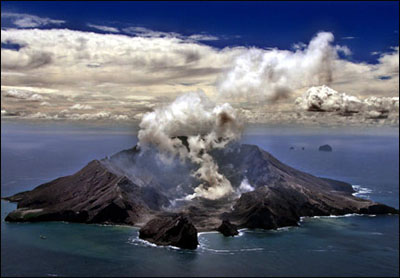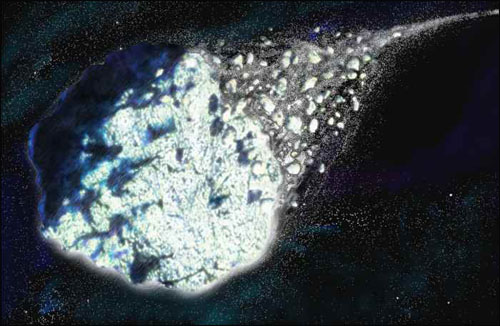
Comets most likely made Earth habitable for life.
As reported in ScienceDaily, gases which formed the Earth's atmosphere -- and probably its oceans -- did not come from inside the Earth but from outer space, according to a study by University of Manchester and University of Houston scientists.
The report published in the journal Science means that textbook images of ancient Earth with huge volcanoes spewing gas into the atmosphere will have to be rethought.
According to the team, the age-old view that volcanoes were the source of the Earth's earliest atmosphere must be put to rest.
Using world-leading analytical techniques, the team of Dr Greg Holland, Dr Martin Cassidy and Professor Chris Ballentine tested volcanic gases to uncover the new evidence.
The research was funded by Natural Environment Research Council (NERC).
"Until now, no one has had instruments capable of looking for these subtle signatures in samples from inside the Earth -- but now we can do exactly that." --Dr Greg Holland the project's lead scientist.
The study is also the first to establish the precise composition of the Krypton present in the Earth's mantle.
Project director Prof Chris Ballentine of The University of Manchester, said: "Many people have seen artist's impressions of the primordial Earth with huge volcanoes in the background spewing gas to form the atmosphere.
"We will now have to redraw this picture."
Oceans also imported fro "out there"
Contrary to preconceived notions, the atmosphere and the oceans were perhaps not formed from vapors emitted during intense volcanism at the dawning of our planet. Francis Albarede of the Laboratoire des Sciences de la Terre (CNRS / ENS Lyon / Universite Claude Bernard) suggests that water was not part of the Earth's initial inventory but stems from the turbulence caused in the outer Solar System by giant planets. Ice-covered asteroids thus reached the Earth around one hundred million years after the birth of the planets.
The Earth's water could therefore be extraterrestrial, have arrived late in its accretion history, and its presence could have facilitated plate tectonics even before life appeared. The conclusions of the study carried out by Albarede feature in an article published on the 29 October 2009 in the journal Nature.
Space agencies have got the message: wherever there is life there has to be water. Around 4.5 billion years ago, the Earth was bequeathed with sufficient water for oceans to form and for life to find favorable niches in the seas and on the continents resulting from plate tectonics. In comparison, the Moon and Mercury are dry, mortally cold deserts, Mars dried up very quickly and the surface of Venus is a burning inferno.
According to books, the ocean and the atmosphere were formed from volcanic gases and the Earth's interior is the source of volatile elements. However, the rocks of the Earth's mantle are deficient in water (geochemists estimate its concentration at two hundredth percent). The same is true on Earth's sister planets, Venus and Mars. The main reason proposed by Albarede is that, during the formation of the Solar System, the temperature never dropped sufficiently between the Sun and the orbit of Jupiter for volatile elements to be able to condense with planetary material. The arrival of water on Earth therefore corresponds to a late episode of planetary accretion.
It is widely accepted that terrestrial planets are formed over several million years by the agglomeration of asteroids (of kilometric size) then protoplanets (of the size of Mars). The arrival of the last of these large objects corresponds to the lunar impact, 30 million years after the formation of the Solar System. Initially, this hurly-burly took place between planetary objects located within the snow line, in other words between the Sun and the asteroid belt. This space, swept by the electromagnetic winds of the young Sun, was then too hot for water and volatile elements to condense within it.
The major delivery of volatile elements on our planet could have corresponded to a phenomenon that occurred some tens of millions of years after the lunar impact: this was the big clean up of the outer Solar System initiated by the giant planets. Due to their very strong gravity, they sent the final ice-rich planetary rubble in all directions, including in our own direction. Penetrating into the mantle through the surface, the water could then have softened the Earth and reduced the strain at which materials shatter. Plate tectonics then began and with it the emergence of continents, conditions probably necessary for the appearance of life. Mars dried out before water managed to penetrate in depth and, as regards Venus, the conditions that reigned before the violent remodeling of its surface, 800 million years ago, by intense volcanism are still not known.
At a time when the habitability of extraterrestrial planets is beginning to be explored seriously, understanding what made earth the only place that harbors life is a key question.
References: Greg Holland, Chris J. Ballentine, Martin Cassidy. Meteorite Kr in Earth's Mantle Suggests a Late Accretionary Source for the Atmosphere. Science, 2009;
Comments:
|

